If I correctly understand what you're asking, reconstruction filtering can be done in either the digital or the analog domains, or usually in both. Digital filters objectively perform much better than do analog filters, although digital filtering always leaves some residual out of band image products. These residual products can be completely removed via an relatively low order analog filter, or are sometimes simply ignored. Subjectively, there remains controversy over what some hear as the adverse affect of hardware based digital filters. Hence, the popularity of NOS (digital filter-less) DACs.
Thanks! Trying to understand how DACs work I came across two articles. The first one: http://lavryengineering.com/pdfs/lavry-sampling-oversampling-imaging-aliasing.pdf explains that oversampling helps to restore the audio HF roll off and to push the reconstruction images to higher frequencies. Let's keep this and move the filter to the analog domain. Here comes the other article: http://www.eetimes.com/document.asp?doc_id=1274874 in figure 3-54 (attached for your convenience) gives an example of I/V conversion with incorporated common and differential mode filters. Would this scheme -in general- be effective without the necessity of the digital filter?
Attachments
Its -2.5db at 20K so won't be down much at 10k, let alone 5k.
I'd challenge anyone to do a blind listening test with a switchable filter. Theory does not always translate into audible differences in my experience.
There are people who can hear 0.2 dB differences at midrange frequencies under double-blind conditions. I'm sure I can't, but there are people who can (see The Great Debate: Subjective Evaluation, Stanley Lipshitz and John Vanderkooy, Journal of the Audio Engineering Society, Volume 29, Issue 7/8, August 1981, pages 482...491).
In any case, for argument's sake, suppose it were just below audibility. I would like the frequency response of the whole signal chain to be flat, so it would be silly to allow an audible or almost audible error in a DAC that's only one small piece of the chain, especially when it is relatively straightforward to correct for its roll-off.
Thanks! Trying to understand how DACs work I came across two articles. The first one: http://lavryengineering.com/pdfs/lavry-sampling-oversampling-imaging-aliasing.pdf explains that oversampling helps to restore the audio HF roll off and to push the reconstruction images to higher frequencies. Let's keep this and move the filter to the analog domain. Here comes the other article: http://www.eetimes.com/document.asp?doc_id=1274874 in figure 3-54 (attached for your convenience) gives an example of I/V conversion with incorporated common and differential mode filters. Would this scheme -in general- be effective without the necessity of the digital filter?
I don't see any common-mode filter and the differential filter has a very slow roll-off, so it would not be very effective.
abraxalito has some examples of filters that are far more effective and correct for the sin(x)/x roll-off.
Last edited:
Images are byproducts of the conversion back to analogue. Sampling produces aliases, which people often confuse with images.
If oversampling is to happen then this must take place before the DAC; oversampling is a digital technique so the signal needs to be in the digital domain for this to happen.
The main purpose of oversampling is to achieve better reconstruction filtering; some of the filtering is done digitally, then the signal goes through the DAC, then there is a final analogue filter - which can be simpler than would be needed if it was doing the whole job itself.
NOS fans want to avoid all this precision, as they prefer the sound of rolled-off signal accompanied by images.
Thanks for the clarification. I always thought that the NOS fans accepted the HF roll off and images as a necessary compromise in order to avoid the phase shift problems associated with the digital -and analog- filters. This is the origin of my question: can oversampling be done separately from filtering, has anybody done this or it wouldn't work? Is the oversampling itself that could introduce phase problems?
Digital filters can quite easily be made perfectly phase linear. Whether you should want them to be perfectly phase linear is the subject of debate, though.
Analogue filters can not be made perfectly phase linear, but they can be made nearly phase linear in their passband when you need only a smooth roll-off - like in oversampled DACs.
Analogue filters can not be made perfectly phase linear, but they can be made nearly phase linear in their passband when you need only a smooth roll-off - like in oversampled DACs.
I don't see any common-mode filter and the differential filter has a very slow roll-off, so it would not be very effective.
Thanks for reply! Do we know what part of the DAC's noise -reconstruction images, aliasing etc- is common mode and what is differential?
Digital filters can quite easily be made perfectly phase linear. Whether you should want them to be perfectly phase linear is the subject of debate, though.
Analogue filters can not be made perfectly phase linear, but they can be made nearly phase linear in their passband when you need only a smooth roll-off - like in oversampled DACs.
OK. But that would mean that NOS fans simply don't like flat frequency response and linear phase... Perhaps in real life no one bothers to make what is so easy to be made?
Phase-linear digital filters are actually quite common. A non-oversampling DAC without reconstruction filter (except for the zeroth order hold) also has a linear phase response. On the other hand, a non-oversampling DAC with analogue reconstruction filter usually has a quite non-linear phase response.
I don't know what attracts people to non-oversampling DACs without reconstruction filter (other than the zero-order hold). It could be that they simply like the slight treble roll-off, it could be that they dislike the imperfections of commercial digital filter chips (clipping on intersample overs, pre-echoes due to passband ripples, effects of rounding of intermediate results), it could be that they are somehow affected by the ultrasonic images and like that.
I don't know what attracts people to non-oversampling DACs without reconstruction filter (other than the zero-order hold). It could be that they simply like the slight treble roll-off, it could be that they dislike the imperfections of commercial digital filter chips (clipping on intersample overs, pre-echoes due to passband ripples, effects of rounding of intermediate results), it could be that they are somehow affected by the ultrasonic images and like that.
OK. But that would mean that NOS fans simply don't like flat frequency response and linear phase... Perhaps in real life no one bothers to make what is so easy to be made?
That conclusion doesn't necessarily follow. Perhaps, some other aspects of the subjective reproduction are overriding the significance of a non-flat frequency response (which is easy to EQ flat) and the presence of the unsuppressed ultra-sonic image bands. I've extensively experimented with an NOS DAC in the past, and while I heard some undesirable qualities, I also experienced the non-fatiguing quality which is the raison' detre of NOS DACs.
Typical oversampled CD replay too soon leaves me feeling oddly bored, or anxious for the music to end. To me, this may be the greatest sin a music replay system can commit. There's no subjectively apparent distortion or frequency response anomaly. Instead, it's like some sort of subconscious stress mechanism sneaks in and progressively induces aural or pshychological fatigue while listening. I've listened to oversampled CD replay that simply sounds excellent, until boredom or anxiety weirdly and unexpectedly sets in. I didn't experience that disappointing effect via NOS, despite it exhibiting subjective flaws of it's own.
Last edited:
I've listened to oversampled CD replay that simply sounds excellent, until boredom or anxiety weirdly and unexpectedly sets in.
My guess would be it is nature of the low level high order distortion that gives the effects you describe. Actually, not too many things it could be. I am pretty practiced at listening for low level distortion, and sometimes the effect of it can be about as you say. On the other hand, even higher levels of very low order distortion may sound relaxing and very pleasant. Right now I can make the dac I am working on sound the bad way we are probably talking about, or quite nice and near SOA quality. In the case at the moment it has to do with its jitter behavior and what the ASRC DPLL is doing.
SMPS noise can cause similar audible effects, IME, and usually does in most dacs that use it. DAC-3 is the only exception I can think of, although there may be others.
Interestingly, people have also expressed disappointment with how some LDO powered dacs sound despite that regulators look very good on paper. Nobody seems to have investigated why, or tried to find a fix. Rather, some folks have chosen to abandon LDOs altogether.
Hard to understand why the audio design engineering community and dac chip manufacturers haven't made more effort to make progress in understanding the issues. Presumably, there is no money to be made on it.
Last edited:
I don't know what attracts people to non-oversampling DACs without reconstruction filter (other than the zero-order hold).
My best guess (its only a guess) at present is they are appreciating the absence of opamp-based filtering stages post-DAC. The canonical NOS DAC I take to be a TDA1543 with passive I/V - no active stages beyond the DAC itself. As to whether the images help the SQ, in my experience they don't. I get much more enjoyment from adding a fairly steep filter after the DAC (TDA1387) than I do without the filter.
thanks, now much clearer!
Hello, I have built the compensated filter this night....
Response is now pretty flat (-0.5dB only!) but group delay slight worse (9us). I like both versions...need to decide which I prefer.
Today I will test both by ear (LTSpice flat and DAC flat), not 100% sure that I prefer the compensated DAC_flat one as 3D sounding imaging of the not compensated one was extremely focused...
Will post full results and comments probably in another thread where I'm comparing TDA1543/CS4303/PCM1710...but PCM56 measurements and sounding performance are really amazing in any case...
THD 0dB = 0.0025% (with PC soundcard, at my Power amplifier output!)
THD -60dB= 1.5%
THD -80dB= 11% after MSB error adjustment
J-test jitter < 100dB with coax input and CS8412
Hello, I have built the compensated filter this night....
Response is now pretty flat (-0.5dB only!) but group delay slight worse (9us). I like both versions...need to decide which I prefer.
Today I will test both by ear (LTSpice flat and DAC flat), not 100% sure that I prefer the compensated DAC_flat one as 3D sounding imaging of the not compensated one was extremely focused...
Will post full results and comments probably in another thread where I'm comparing TDA1543/CS4303/PCM1710...but PCM56 measurements and sounding performance are really amazing in any case...
THD 0dB = 0.0025% (with PC soundcard, at my Power amplifier output!)
THD -60dB= 1.5%
THD -80dB= 11% after MSB error adjustment
J-test jitter < 100dB with coax input and CS8412
Attachments
-
PCM56 compensated.asc9.5 KB · Views: 77
-
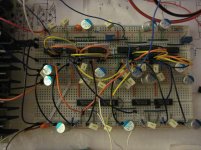 IMG_2619.jpg398 KB · Views: 244
IMG_2619.jpg398 KB · Views: 244 -
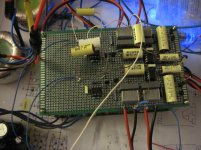 IMG_2620.jpg429.8 KB · Views: 228
IMG_2620.jpg429.8 KB · Views: 228 -
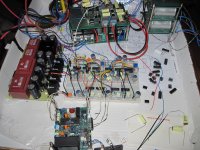 IMG_2632.jpg880.4 KB · Views: 242
IMG_2632.jpg880.4 KB · Views: 242 -
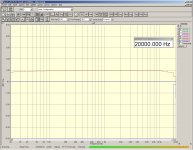 PCM56 3x frequency response breadboard 1nF+6.5nF LTspice compensated.jpg312.3 KB · Views: 233
PCM56 3x frequency response breadboard 1nF+6.5nF LTspice compensated.jpg312.3 KB · Views: 233 -
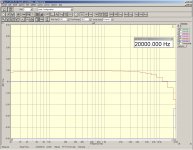 PCM56 3x frequency response breadboard 4.3nF LTspice flat.jpg303.2 KB · Views: 221
PCM56 3x frequency response breadboard 4.3nF LTspice flat.jpg303.2 KB · Views: 221 -
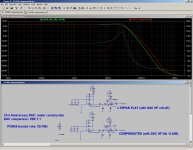 PCM56 3x LTSPICE simulation.jpg459.6 KB · Views: 145
PCM56 3x LTSPICE simulation.jpg459.6 KB · Views: 145
Last edited:
Indeed useful info! I'll add my experience with NOS. I cannot perceive anything about the ultrasonic hash, but the treble roll off is definitely there and feels as described by Ken Newton. That said, I was attracted by the sound so much that initially I made thoughts to live with the non flat FR. But no, I can't force myself to this. If not oversampling what other options exist? I can do FR equalization on speakers crossover. Would that work? What about upsampling done in the audio playback software? How does this compare to real oversampling?
"Something else to notice is that as the frequency increases, with fewer samples to define the sinusoidal wave (since we only have 44.1kHz sample points), notice that many of the frequency peaks do not reach the full amplitude of the sine wave with the NOS output. This correlates with the dip in high frequency amplitude response which we can easily measure:..."
Archimago's Musings: NOS vs. Digital Filtering DACs: Exploring filtering turned off, implications, fidelity and subjective audibility. (Recent BorderPatrol DAC chatter...)
//
Archimago's Musings: NOS vs. Digital Filtering DACs: Exploring filtering turned off, implications, fidelity and subjective audibility. (Recent BorderPatrol DAC chatter...)
//
Oversampling is stuffing new samples between real (repeating at 44.1 kHz or 48 kHz rate) samples. If the new samples in between are identical to the previous real sample, that has nil effect. The goal usually is to "guess" the original analog value at the new samples. It can be done by linear approximation or higher order function, that is using some kind of digital filter. A digital filter can be created to be linear phase.... can oversampling be done separately from filtering, has anybody done this or it wouldn't work? Is the oversampling itself that could introduce phase problems?
I was attracted by the sound so much that initially I made thoughts to live with the non flat FR. But no, I can't force myself to this ...
I would like to remind you that here we are allowed to build machines for our own exclusive pleasure and not to market them.
The machines on the market "must" have a flat response, and the graphics have to prove it in order to be sold. The Onkyio 6130 has an extremely flat analog response (it's my digital source and I've just measured it for comparison) with its AKM's premium AK4452 768 kHz / 32-bit DAC. And it sounds extremely clean, but it does not excite me at all!
The NOS TDA1543 / PCM56 44.1 kHz / 16-bit which I have just built on such messy breadbords have already outclassed it: as said I will go to listen to both versions for few days (compensated and flat, but with greater group delay, or not compensated with -3dB roll-off, but with negligible group delay). And, if at some point, I eventually enjoy more the un-compensated one for longterm listening, I will keep it, because it would give me the greatest satisfaction, even if its frequency response is disgusting on the paper and I have a "flat response" source DAC available at few centimeters close to it...
That is the great advantage of DIY!
(I will probably test also a trade-off between the two, with just -1.5dB roll-off).
Phase-linear digital filters are actually quite common. A non-oversampling DAC without reconstruction filter (except for the zeroth order hold) also has a linear phase response. On the other hand, a non-oversampling DAC with analogue reconstruction filter usually has a quite non-linear phase response.
I don't know what attracts people to non-oversampling DACs without reconstruction filter (other than the zero-order hold). It could be that they simply like the slight treble roll-off, it could be that they dislike the imperfections of commercial digital filter chips (clipping on intersample overs, pre-echoes due to passband ripples, effects of rounding of intermediate results), it could be that they are somehow affected by the ultrasonic images and like that.
Oversampling is stuffing new samples between real (repeating at 44.1 kHz or 48 kHz rate) samples. If the new samples in between are identical to the previous real sample, that has nil effect. The goal usually is to "guess" the original analog value at the new samples. It can be done by linear approximation or higher order function, that is using some kind of digital filter. A digital filter can be created to be linear phase.
I can understand a bit better the function of digital filters now! The next step in my novice quest for the "ideal" DAC could be NOS with analog filter that sacrifices the audio spectrum above 15kHz if that helps to keep intact the rest with respect to frequency and phase linearity and FR equalization.
Ygg-it, I'm following with interest! Me neither care about flat FR from 20Hz-20kHz. But I need it to be flat at least until 12kHz if not 15kHz. Pure NOS seems that it doesn't do that.
I have been thinking about a different kind of NOS DAC for a while:
It does not need to be zero-order sample-and-hold, i.e. staircase analog output. My idea is to form each sample as a very short "spike" of converted amplitude, and zero between the spikes. A conventional analog filter should follow.
Is there any mathematically talented among us who can perform the Fourier trasform and provide the resulting spectrum?
It does not need to be zero-order sample-and-hold, i.e. staircase analog output. My idea is to form each sample as a very short "spike" of converted amplitude, and zero between the spikes. A conventional analog filter should follow.
Is there any mathematically talented among us who can perform the Fourier trasform and provide the resulting spectrum?
- Status
- Not open for further replies.
- Home
- Source & Line
- Digital Line Level
- Frequency response of NOS DAC
